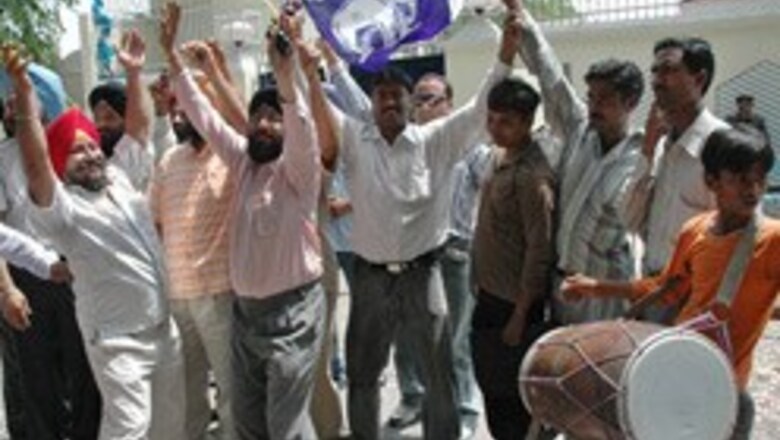
views
Okay, we all know the social chemistry of the BSP’s victory. We know that the BSP is a Dalit party, that this time it stitched together an alliance with Brahmins and some Muslims and thus bypassed the Other Backward Communities (OBCs). Thus the BSP’s extraordinary success is all about caste arithmetic. Or so we think.
Here are four reasons why we need to revise this formulation. First, the BSP has never been just a Dalit party, just as the BJP has never been just an upper caste party. The BSP has always drawn more than one-third of its votes from non-Dalits. These ‘plus votes’ have always been critical to the BSP’s electoral success. The difference this time was that the proportion of non-dalit votes went up from about two-fifth to nearly half of the BSP’s votes.
Mayawati’s society
Second, it was not just the Brahmins but all of what Mayawati called the “upper caste samaj”. The BSP vote share among various upper castes was not very different: 17 per cent among Brahmins, 12 per cent among Rajputs, 14 per cent among Vaishyas and 16 per cent among other upper castes. This was a three-fold increase over the BSP’s vote share in this segment in the last election. Yet let us not forget that, in all, upper castes comprised only about one-tenth of the BSP’s voters.
Third, the bulk of the BSP’s non-dalit votes came not from the upper castes but from the lower OBCs. If you exclude the dominant peasant communities like the Yadavs, Kurmis and Lodhs, the BSP was the first preference of the rest of the OBCs.
The BSP got on an average more than 30 per cent of the votes in this group. The non-dominant OBCs contributed about one-fifth to the total votes of the BSP, twice as much as the upper castes. The BSP also got about 17 per cent votes among the Muslims, a little more than it did among all the upper castes.
PAGE_BREAK
Fourth, it was not just about caste: class and gender played a crucial role in the BSP’s success. The class slope of the BSP’s vote is not different from the textbook illustration of the social basis of the communist parties: the vote share shoots up sharply from 15 to 41 as you go from the rich to the poor. And this is not merely because Dalits are also poor. Within each caste group, the BSP got substantially more votes among the poor than it did among the rich. Among women the BSP got two percentage points votes more than it did among men. You might think this is a tiny difference, but the BSP may have fallen short of a majority in the absence of this additional support among women.
In other words, we are not looking at a one-caste party like the Apna Dal or a two-caste alliance like the SP. Nor is it a rainbow coalition of the old-Congress variety. The BSP’s social coalition is like that of Lalu Prasad Yadav at his height: it is a coalition of the downtrodden. Perhaps no electoral verdict combined all the axes of social disadvantage in our society—caste, class, gender, region and urban-rural—as this historic victory of the BSP. We need to notice that the BSP did better in rural areas and in the least developed regions like Bundelkhand and Eastern UP.
Three layers of support
It is best to see the BSP’s support as comprising three layers: core, auxiliary and floating voters. The core support is caste-based from among all Dalits who comprise 22 per cent of UP’s population. Class or gender make no difference here, nor is there much difference between jatavs and non-jatavs. This base vote is quite inelastic and leaves Mayawati free to court any other community in any way she pleases.
The auxiliary support is a mix of caste, class and gender. It comes from the poorest cutting across caste and from caste groups closest to dalits—artisans, service and non-dominant peasant OBCs—more women than men. This support has been with the BSP for some time and can become an enduring asset, provided the BSP uses its state power to cultivate its support.
The floating vote is the smallest and most transient component of the BSP’s support, but it gets the highest media attention. This reflects the dividends of some of the high-profile caste alliances with brahmins and Muslims etc. But this vote is most sensitive to issues, perceptions of governance and to the social profile of candidates.
How we understand the BSP’s social coalition makes a difference to how we understand the future of UP’s politics. With this election the BSP has reached a saturation point of its core vote — its vote share among Dalits is one of the highest recorded for any one large social group in any state of India since Independence. If it is a two-caste coalition, the challenge is to strengthen the new vote bank of the ‘upper caste samaj’. If it is a coalition of the oppressed, the challenge for the BSP is to come up with a different kind of policy initiatives addressed to the multiple disadvantages that mark contemporary UP.
1996
2002
2007
Upper Caste
4%
5%
16%
OBC (non-Yadav)
13%
20%
27%
Muslims
12%
10%
17%
Dalits
62%
69%
77%
All
Rich
Poor
All
31
15
41
Brahmin
17
12
27
Rajput
12
10
14
Jat
13
11
22
Kurmi
16
12
20
Yadav
08
05
05
Other Peasant OBC
34
27
34
Lower OBC
28
18
30
Jatav
85
73
86
Other Dalits
55
30
56
Muslims
17
12
18


















Comments
0 comment